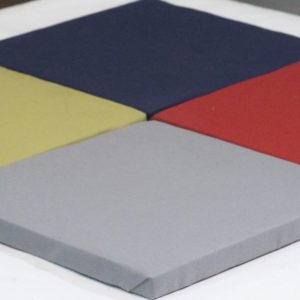At Commercial Acoustics, we approach every new absorption project with the same mindset – determine how much absorption is needed, then provide it in a cost-effective and timely manner. There are a few characteristics that typically demand some type of acoustic treatments – high vaulted ceilings, smooth walls, and no plush materials such as carpets and heavy drapes. When you notice an unwanted reverberation in your space, you can call an acoustical contractor, or just calculate your needed treatment.
Acoustic Calculator – Calculating Required Acoustic Treatment

Sabins Calculation Explained
To determine how much absorption you need in your space, follow the steps below:
First, calculate how many square feet the room is, and how tall the walls are. Multiply these units together, and you have the cubic volume of your space.
Then, add together the total square footage available in the room.
How absorptive is each surface? Check out our absorption coefficients here. The absorption coefficients (often called NRC, or Noise Reduction Coefficient) of each surface is a measure of how much inbound sound the surface absorbs. A good rule of thumb is, that if it absorbs water, it’ll absorb sound. So while glass, polished concrete and steel generally repel water (at least at first), they also reflect sound. On the other hand, carpet, Acoustic Ceiling Tile (ACT), and plush curtains absorb water, and are excellent sound absorbers as well.
Total Surface Area = SA_floor + SA_walls + SA_Ceiling
The worst absorptive surfaces are hard, flat, and smooth. If they are parallel, that further worsens the situation.
The worst case scenario is a room of painted drywall that is a perfect cube, allowing resonant sound waves to reverberate continuously with minimal absorption or attenuation.
If there are no plush carpets or furniture in the room, you are likely to have additional echo issues.
Sound Absorption Example Calculation
Example 1: You have a 20’ x 20’ room, with 16’ tall walls. The ceiling and walls are painted drywall, and the floor is painted concrete. This is a gym used for yoga, but the instructor has a difficult time talking to students due to the echo.
The area of the room is 20×20 = 400 sq ft. This is not exceptionally large, and usually would not be a problem if it weren’t for all of the hard surfaces.
Total area of the walls is 4 x (Area of Each Wall), or 4 x 20 x 16 = 1280 sq ft
Finally, the area of the ceiling is the same as the area of the floor, which is 400 sq ft.
Now, let’s determine the total volume of the room. Because it is a rectangular prism, it is simply 20x20x16, or 6400 cubic feet.
Finally, we just need to determine how much acoustic absorption space we have. In this case, painted drywall has an NRC, or acoustic coefficient, of 0.1. That means it reflects 90% of the sound that impacts against it, and absorbs only 10%. Likewise, painted concrete only absorbs approximately 10%.
To find the absorption area of the floor, we multiply the area of the floor by the NRC of the floor. 400 sq ft x 0.1 NRC = 40 Sabins.
The ceiling and the walls follow the same approach:
Ceiling = 400 sq ft x 0.1 NRC = 40 Sabins
Walls = 1280 sq ft x 0.1 NRC = 128 Sabins
Therefore, the Total Sabins, or acoustic absorption in the room is 208 Sabins.
Now, let’s plug this in to the Sabins Formula: RT = .049*V/A
We find that the reverb time in the space is 1.5 seconds, which explains why it is so poor. Compare that against the table of acceptable reverberation times here.
*There are other considerations, although this simplified model does give fairly accurate results.
For instance, is there furniture, which can often increase the NRC of the room? Also, parallel walls allow standing waves to develop, which amplify the reverberation in the room. That’s why some minor absorption may be need even in small team rooms with carpet and ceiling tile. The parallel walls still give enough flutter echo that sensitive microphones may pick it up.

How to Measure Sound Absorption
Briefly mentioned above, sound absorption is measured by the NRC, or Noise Reduction Coefficient, of a material. The NRC of a material tells you how much sound a material absorbs and how much sound a material reflects. For example, acoustic wall panels have an NRC rating of 1.0, so they absorb 100% of the sound waves that come into contact with them, and reflect 0% of sound waves.
Similarly, some acoustic ceiling tile has an NRC of 0.45, so it absorbs 45% of the sound waves that come into contact with it, and reflects the other 55% of sound waves.
The Acoustic Calculation Formula – In a Nutshell
So, in conclusion, the reverberation time of a space (how “echoey” it is), depends on a few factors. Most notably:
- The size of the room: LxWxH
- The absorptive property of each surface: Walls, Ceiling, and Floor
Large floor plans with tall ceilings and reflective surfaces will generally require some acoustic treatment, especially if there are speaking engagements or other communal activities in the space. On the other hand, small rooms, with plush furniture, acoustic ceiling tile, and heavy carpet may not require any acoustic treatment at all!



